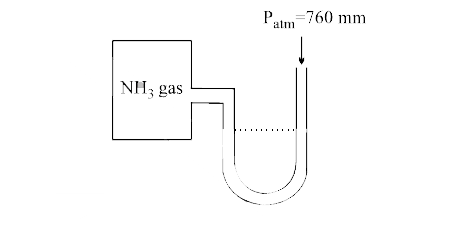A manometer attached to a flask contains with ammonia gas have no difference in mercury level initially as shown in diagram. After sparking into the flask, ammonia is partially dissociated as 2NH3 (g)→N2 (g)+3H2 (g) now it have difference of 6 cm in mercury level in two columns, what is partial pressure of H2 (g) at equilibrium?

9 cm of Hg
18 cm of Hg
27 cm of Hg
None of these
The correct Answer is:C
Step by step video & image solution for A manometer attached to a flask contains with ammonia gas have no difference in mercury level initially as shown in diagram. After sparking into the flask, ammonia is partially dissociated as 2NH_(3)" (g)"rarr N_(2)" (g)"+3H_(2)" (g)" now it have difference of 6 cm in mercury level in two columns, what is partial pressure of H_(2)" (g)" at equilibrium? by Chemistry experts to help you in doubts & scoring excellent marks in Class 12 exams.
Updated on:21/07/2023Topper's Solved these Questions
Similar Questions
A manometer attached to a flask contains NH3 gas have no difference in mercury level initially as shown in diagram.After the sparking into the flask, it have difference of19 cm in mercury level in two columns.Calculate % dissciation of ammonia

View SolutionAmmonia is prepared as
3H2(g)+N2(g)→2NH3(g)
What should be the sign of ΔS for this reaction? Explain.
View Solution
Knowledge Check
A manometer attached to a flask contains with ammonia gas have no difference in mercury level initially as shown in diagram. After sparking into the flask, ammonia is partially dissociated as 2NH3 (g)→N2 (g)+3H2 (g) now it have difference of 6 cm in mercury level in two columns, what is partial pressure of H2 (g) at equilibrium?
 A18 cm HgB9 cm HgC27 cm HgD24 cm Hg
A18 cm HgB9 cm HgC27 cm HgD24 cm HgThe enthalpy of formation of ammonia is −46.0KJmol−1 . The enthalpy change for the reaction 2NH3(g)→N2(g)+3H2(g) is :
A46.0KJmol−1B92.0KJmol−1C−23.0KJmol−1D−92.0KJmol−1The enthalpy of formation of ammonia is −46.0KJmol−1 . The enthalpy change for the reaction 2NH3(g)→N2(g)+3H2(g) is :
A46.0 kJ mol−1B92.0kJmol−1C−23.0kJmol−1D−92.0kJmol−1
An open ended mercury mnometer is used to measure the pressure exerted by a trapped gas as shown in the figure. Initially manometer shows no difference in mercury level in both columns as shown in diagram.

After sparking A dissociates according to following reaction:
2A(g)→3B(g)+2C(g) ltbr> If pressure of Gas A decreases to 0.8 atm. Then:
(Assume temperature to be constant at 300K)
View SolutionA open ended mercury manometer is used to measure the pressure exerted by a trapped gas as shown in the figure. Initially manometer shows no difference in mercury level in both columns as shown in diagram.

After sparking 'A' dissociates according to following reaction
A(g)→B(g)+3C(g)
If pressure of Gas "A" dissociates to 0.9 atm, then (Assume temperature to be constant and is 300 K)
View SolutionA monometer contains a liquid of density 5.44g/cm3 is attached to a flask containing gas 'A' as follows

The initial pressure of gas A in th flask is:
View SolutionWhich of the following is correct for the reaction? N2(g)+3H2(g)→2NH3(g)
View SolutionVapour density of the equilibrium mixture of the reaction
2NH3(g)⇔N2(g)+3H2(g) is 6.0 Percent dissociation of ammonia gas is :
View Solution
